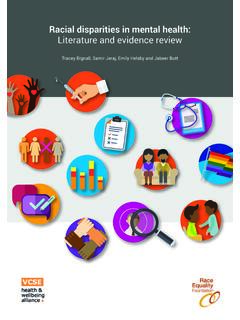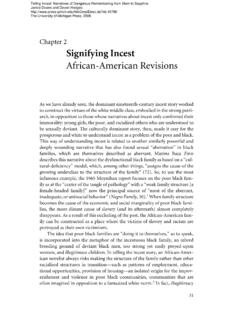Transcription of CULTURAL INFLUENCES ON EARLY LANGUAGE AND …
1 ZERO TOTHREES eptember 200652 Note: This article is excerpted from a chapter inCradlingLiteracy, forthcoming from the ZERO TO THREE and Danielle were coteachers in a 2- and 3-year-oldclassroom. They enjoyed working together most of the time,but occasionally what seemed like minor issues caused themto make some pointed comments that silenced them example, Lisa believed the children were too young to behandling scissors during art projects and would observealoud, They don t know how to cut anyway. Daniellewould respond by rolling her eyes and saying, Well, that isexactly why the children should be using scissors. They needto practice to learn how to use scissors. Setting out foodalso seemed to elicit a minor conflict. Lisa set up a very gen-erous table full of goodies for the children to snack would often comment that it offered too manychoices for the children .
2 She was also concerned that chil-dren waste too much food. Lisa would then counter withher view that snack time should be a fun activity that stimu-lated LANGUAGE . Besides, why are we saving food? There isplenty of food, and if not, we can buy some more. IntroductionLisa and Danielle get along most of the time and aregood friends outside of the work environment, but whatseem to be minor issues can leave them rolling their eyesand unable to see each other s point of view. They getexasperated with what they perceive to be the other s illog-ical way of thinking. Why? Their own upbringing and theircultural perspectives about children influence their percep-tions of even everyday activities such as using scissors andeating snacks. We all bring specific values, beliefs, andCULTURALINFLUENCES ONEARLYLANGUAGE ANDLITERACYTEACHINGPRACTICESREBECCAPARLA KIANZERO TO THREEandSYLVIAY.
3 SA NCHEZG eorge Mason University Graduate School of Educationassumptions about child-rearing and child development toour work with infants and toddlers. Even two colleagueswho share same ethnic culture may not share the samebeliefs about what s best for very young children , whatexperiences they need, and what our expectations for theirdevelopment should be. Conflicts around these issues will,quite naturally, arise with our colleagues and the parents ofchildren in our care . Learning how to recognize the other spoint of view and come to some shared solution is criticalin providing high quality care to infants and learn to communicate in the context of theirhome culture. Beginning at birth, children use theirhome LANGUAGE and culturally accepted communica-tion styles to connect with others in a meaningful way,forming secure relationships that are intrinsic tohealthy development.
4 For the EARLY childhood teacher,it is important to establish supportive, respectful rela-tionships as well with both families and connections help teachers learn more about thestrengths, needs, and culture of every child in theircare. Collaborative relationships with families alsoprovide teachers with the information they need tosupport children s individual LANGUAGE and literacydevelopment. By creating a richly diverse and welcom-ing environment, by remaining aware of their owncultural beliefs (and biases), and by identifying a vari-ety of teaching strategies to share the magic of printand LANGUAGE , EARLY childhood teachers can spark alifelong love of reading in the children they care TOTHREES eptember 200653cultural knowledge, linguistic knowledge, culturallyinformed teaching knowledge, knowledge of multiculturalmaterials and literacy methods, and knowledge of home-school relationships (Abt-Perkins & Rosen, cited in Willis,2000).
5 Each will be discussed in more detail below.(1) teachers can address the lit-eracy needs of children in their care , they must firstbecome aware of their own CULTURAL beliefs and is defined as a thorough understanding ofone s own CULTURAL roots and group affiliations (Haberman& Post, cited in Willis, 2000). A teacher s culture, lan-guage, social interests, goals, and values especially whenthey are different from the children in the program cancreate a barrier to understanding how best to support thelearning of the children in her care (Orange & Horwitz,cited in Willis, 2000). By reflecting on their own culturalbeliefs and practices about teaching and learning, teacherscan better understand the CULTURAL perspective they bringto the EARLY childhood is also important to consider the knowledge we haveacquired from our professional education.
6 Our traininggives us a CULTURAL lens through which we interpret chil-dren s behavior and skills. This professional perspectiveprobably includes information about what are considered best practices in teaching LANGUAGE and literacy skills andwhat are considered developmentally appropriate skillsfor children aged birth to 5. As we get to know variouschildren, families, and cultures, we may find these profes-sional standards challenged in various process of reflection can become complicatedwhen teachers are members of the mainstream groups, whether by race or class, are oftenunaware of their CULTURAL identity because their culturalbeliefs comprise the mainstream standard of what is consid-ered normal or typical (Tatum, cited in Willis, 2000).Minority CULTURAL groups may be more aware of their iden-tity because external images and practices often do notreflect their beliefs of their family or community.
7 Somepotential CULTURAL differences related to LANGUAGE and liter-acy learning are outlined below. Take a few moments toreflect on your and your family s beliefs and practices ineach of these areas. When do you believe that children should begin to acquirelanguage and literacy skills? Do you believe it is importantto speak to children (babies) who are preverbal? What is the correct way to interact with books and otherliteracy materials? For example, how do you feel aboutbabies sucking and chewing on books? Do you think parents should take on a teaching rolewhen it comes to LANGUAGE and literacy skills? Do you prefer to read stories to children , tell stories, orsing songs? Why do you think that might be?When teachers become aware of their CULTURAL backgroundsand values, they can begin to address any preconceivedHow we view the world is shaped by the beliefs, val-ues, and experiences of prior generations of our respectivefamilies.
8 Each generation has refined its sense of what ismost important for children to know, believe, value, anddo to ensure survival of the CULTURAL and social commu-nity. This unique family culture is passed on to the newgeneration through the stories that are told to childrenand through the family and community s child-rearingpractices. As we grow, our individual experiences andinteractions also impact the CULTURAL lens we use to under-stand the world around us. In this way, we are products ofour family and community history, our environment, andour to EARLY LANGUAGE and LiteracySkillsCulture shapes our expectations of what children can and should know and do at various ages. These beliefsinfluence how we interact with children in EARLY childhoodprograms. And the curriculum choices we make based onour beliefs become part of children s life stories, affectingtheir skills, motivation, and excitement about languageand literacy have identified five knowledge basesneeded for teaching in a diverse classroom; learning moreabout each of these can support teachers efforts to pro-mote children s literacy and LANGUAGE learning from birthto age five.
9 These knowledge bases include: self-knowledge,PHOTO: JANETBROWNMCCRACKENZERO TOTHREES eptember 200654notions that could make it difficult for them to accept,understand, and effectively teach children in their care (Willis, 2000).(2) CULTURAL Knowledge. CULTURAL knowledge refers tothe important role that culture plays in shaping children sperceptions, self-esteem, values, behavior, and learning(Willis, 2000). Research on culturally relevant teachingpractices has found that knowledge of children s home cul-tures most importantly their languages, literacy practices,and values can help teachers address the interests andbuild on the skills of their students (Abt-Perkins andRosen, cited in Willis, 2000). Some ways that teachers canlearn about children s cultures include talking with fami-lies, viewing family photographs or videos, involving fami-lies in classroom activities, reading about families cultures,observing interactions between children and families, andattending CULTURAL events in the community.
10 When teachers make an effort to understand family cul-tures, they are better able to individualize the curriculumto ensure that it is meaningful and relevant to , in turn, contributes to children s successful languageand literacy skill acquisition.(3)Linguistic Knowledge. Teachers must also understandhow young children s communication styles and dialectsaffect their learning. Accepting children s home languagescan help them transition to the more standard form of Eng-lish that is an important part of literacy development; asAu notes, with regards to .. literacy learning, proficiencyin standard American English should be seen as a goal, notas a prerequisite to becoming literate (Au, cited in Willis,2000).How can teachers gain linguistic knowledge? By listen-ing to children , talking with parents, and watching parentsand children talk together.





